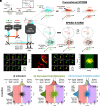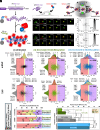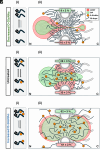O-GlcNAc modulation of nuclear pore complexes orchestrates mRNA export efficiency
- PMID: 40773237
- PMCID: PMC12358868
- DOI: 10.1073/pnas.2502687122
O-GlcNAc modulation of nuclear pore complexes orchestrates mRNA export efficiency
Abstract
Efficient gene expression depends on the tightly regulated export of messenger RNA (mRNA) through nuclear pore complexes (NPCs), which are densely modified by O-linked N-acetylglucosamine (O-GlcNAc). Although dysregulated O-GlcNAcylation has been linked to a variety of human diseases, the precise distribution of O-GlcNAc within the NPC and its effects on mRNA export remain poorly understood. Here, we combined single-point edge-excitation subdiffraction (SPEED) microscopy with stochastic optical reconstruction microscopy (STORM) to map the nanometer-scale distribution of an O-GlcNAc analog (GlcNAz) within NPCs and to quantify the export kinetics of mRNA-protein complexes (mRNPs) under both normal and perturbed O-GlcNAcylation conditions. Under basal conditions, GlcNAz is predominantly localized around the central channel of the NPC. However, both hypo- and hyper-O-GlcNAcylation cause GlcNAz to redistribute toward the nuclear and cytoplasmic peripheries. This shift is paralleled by changes in mRNP localization and altered distributions of key, highly O-GlcNAcylated, phenylalanine-glycine nucleoporins. These architectural rearrangements are accompanied by functional consequences: Elevated O-GlcNAcylation nearly doubles mRNA export efficiency (~61%), while reduced O-GlcNAcylation lowers it to ~16%, along with reduced NPC engagement. The transport receptor TAP exhibits analogous efficiency changes, reinforcing the role of O-GlcNAcylation as a key regulator of nucleocytoplasmic transport. Together, these results suggest that O-GlcNAcylation modulates NPC architecture and transport dynamics to fine-tune mRNA export, and indicate that targeted modulation of NPC O-GlcNAc levels may offer a promising strategy for addressing diseases associated with nuclear transport dysfunction.
Keywords: O-GlcNAc; messenger RNA; nuclear pore complex; posttranslational modification; superresolution fluorescence microscopy.
Conflict of interest statement
Competing interests statement:The authors declare no competing interest.
Figures




Similar articles
-
Prescription of Controlled Substances: Benefits and Risks.2025 Jul 6. In: StatPearls [Internet]. Treasure Island (FL): StatPearls Publishing; 2025 Jan–. 2025 Jul 6. In: StatPearls [Internet]. Treasure Island (FL): StatPearls Publishing; 2025 Jan–. PMID: 30726003 Free Books & Documents.
-
Identification and characterization of O-GlcNAc modifications of a conserved orthopoxvirus core protein.J Virol. 2025 Jun 17;99(6):e0005825. doi: 10.1128/jvi.00058-25. Epub 2025 May 23. J Virol. 2025. PMID: 40407344 Free PMC article.
-
Protein O-GlcNAcylation in reproductive biology and the impact of metabolic disease.Hum Reprod Update. 2025 Jun 26:dmaf013. doi: 10.1093/humupd/dmaf013. Online ahead of print. Hum Reprod Update. 2025. PMID: 40574323
-
Strategies for the Viral Exploitation of Nuclear Pore Transport Pathways.Viruses. 2025 Jan 23;17(2):151. doi: 10.3390/v17020151. Viruses. 2025. PMID: 40006906 Free PMC article. Review.
-
Emerging Roles of Protein O-GlcNAcylation in Bone Remodeling: New Insights Into Osteoporosis.Acta Physiol (Oxf). 2025 Aug;241(8):e70080. doi: 10.1111/apha.70080. Acta Physiol (Oxf). 2025. PMID: 40665904 Review.
References
MeSH terms
Substances
Grants and funding
LinkOut - more resources
Full Text Sources
Miscellaneous

